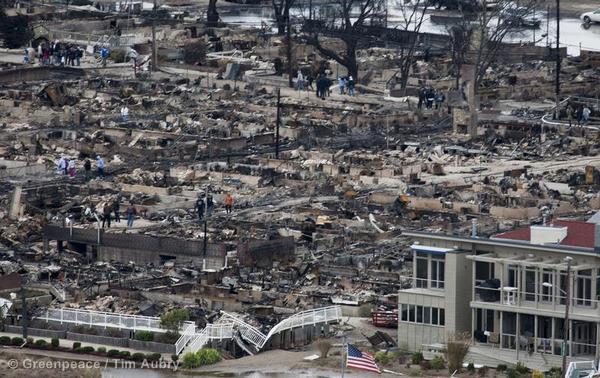People look at the burned out ruins of the Breezy Point neighborhood in the aftermath of Hurricane Sandy. This photo, one of an incredible set of images showing the devastation of one of the most populous areas of the United States by Tim Aubry, is the October 2012 Greenpeace USA Photo of the Month.
I chose this image for the way it illustrates the human impact of the disaster. Shot across the grid of streets, groups of people, perhaps families, inspect the ruins of a modest neighborhood obliterated by the powerful storm. Whole buildings were knocked off their foundations releasing gas which ignited leaving blackened trees and poles where wood frame houses stood.
Around the world similar neighborhoods are filled with families in communities that stand together in the face of difficulties. No where are we prepared for this kind of ferocious force of nature. Turbocharged by a warming climate, Hurricane Sandy wreaked havoc on the lives and fabric of society on its deadly course across the Caribbean and through the Atlantic Ocean. In historic weather patterns, this tropical storm would have weakened in late season colder water, but in a year of record heat waves, severe drought and a new Arctic summer sea ice minimum, it swelled into a superstorm. As a 500 mile wild fury of wind and water, the storm came ashore Oct. 29 in New Jersey and New York with an impact that will be felt for a generation.
The Beach resorts will be rebuilt at a heavy cost to insurers and their customers. Urban neighborhoods in Queens and Staten Island are the places where thousands of people are now homeless. It takes more than money to rebuild a community.
Scientists say that we can expect more of these powerful storms and more frequent extreme weather in the effects of global warming. Reports released today say the climate may warm by 10 degrees by 2100 if we keep this rate of burning fossil fuels. Previous studies concluded that a temperature increase of only 2 degrees would produce catastrophic change. The time for denial of the facts and delay of action has long passed.



